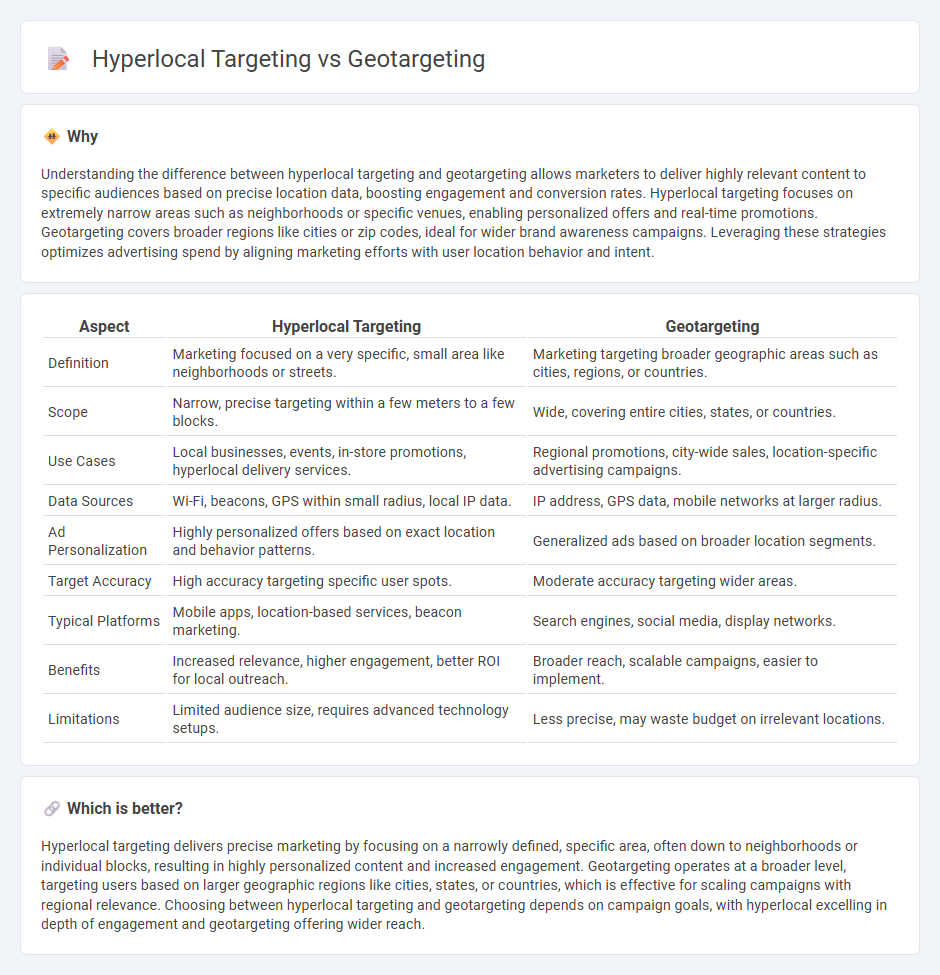
Hyperlocal targeting focuses on reaching customers within a narrow, specific radius, such as neighborhoods or city blocks, maximizing relevance through precise location data and local preferences. Geotargeting broadens the scope by targeting users based on larger geographic areas like cities, states, or countries, leveraging IP addresses or GPS data for location-specific marketing. Explore how these strategies can optimize your campaign's impact and drive higher engagement rates.
Why it is important
Understanding the difference between hyperlocal targeting and geotargeting allows marketers to deliver highly relevant content to specific audiences based on precise location data, boosting engagement and conversion rates. Hyperlocal targeting focuses on extremely narrow areas such as neighborhoods or specific venues, enabling personalized offers and real-time promotions. Geotargeting covers broader regions like cities or zip codes, ideal for wider brand awareness campaigns. Leveraging these strategies optimizes advertising spend by aligning marketing efforts with user location behavior and intent.
Comparison Table
| Aspect | Hyperlocal Targeting | Geotargeting |
|---|---|---|
| Definition | Marketing focused on a very specific, small area like neighborhoods or streets. | Marketing targeting broader geographic areas such as cities, regions, or countries. |
| Scope | Narrow, precise targeting within a few meters to a few blocks. | Wide, covering entire cities, states, or countries. |
| Use Cases | Local businesses, events, in-store promotions, hyperlocal delivery services. | Regional promotions, city-wide sales, location-specific advertising campaigns. |
| Data Sources | Wi-Fi, beacons, GPS within small radius, local IP data. | IP address, GPS data, mobile networks at larger radius. |
| Ad Personalization | Highly personalized offers based on exact location and behavior patterns. | Generalized ads based on broader location segments. |
| Target Accuracy | High accuracy targeting specific user spots. | Moderate accuracy targeting wider areas. |
| Typical Platforms | Mobile apps, location-based services, beacon marketing. | Search engines, social media, display networks. |
| Benefits | Increased relevance, higher engagement, better ROI for local outreach. | Broader reach, scalable campaigns, easier to implement. |
| Limitations | Limited audience size, requires advanced technology setups. | Less precise, may waste budget on irrelevant locations. |
Which is better?
Hyperlocal targeting delivers precise marketing by focusing on a narrowly defined, specific area, often down to neighborhoods or individual blocks, resulting in highly personalized content and increased engagement. Geotargeting operates at a broader level, targeting users based on larger geographic regions like cities, states, or countries, which is effective for scaling campaigns with regional relevance. Choosing between hyperlocal targeting and geotargeting depends on campaign goals, with hyperlocal excelling in depth of engagement and geotargeting offering wider reach.
Connection
Hyperlocal targeting and geotargeting are interconnected marketing strategies that focus on delivering personalized content based on the precise geographic location of consumers. Hyperlocal targeting narrows down to very specific areas such as neighborhoods or streets, enhancing relevance and engagement, while geotargeting uses broader geographic parameters like cities or regions to tailor advertisements. Both approaches leverage GPS data, IP addresses, and mobile device signals to optimize ad performance and increase conversion rates through location-specific messaging.
Key Terms
Location-based Advertising
Geotargeting narrows online ads to specific geographic areas such as countries, regions, or cities, optimizing campaigns for broader local markets. Hyperlocal targeting refines this by focusing on a much smaller radius, often down to neighborhoods or individual streets, delivering highly relevant content to users in micro-locations. Explore more about how location-based advertising strategies can enhance customer engagement and ROI.
Audience Segmentation
Geotargeting narrows audience segmentation by targeting users based on broader geographic areas like countries, states, or cities, optimizing campaigns for regional preferences and behaviors. Hyperlocal targeting refines this segmentation further by focusing on specific neighborhoods or even individual streets, delivering highly personalized and contextually relevant content. Explore detailed strategies to enhance your marketing precision through advanced audience segmentation techniques.
Proximity Marketing
Geotargeting uses broad location data like city or zip code to deliver marketing content, while hyperlocal targeting narrows down to specific neighborhoods or even individual stores to increase relevance. Proximity marketing leverages hyperlocal targeting through technologies like Bluetooth beacons and geofencing to engage consumers within a precise radius, boosting foot traffic and conversion rates. Discover how proximity marketing can transform your local campaigns by integrating hyperlocal targeting strategies.
Source and External Links
Geotargeting - Wikipedia - Geotargeting is the method of delivering different online content or advertisements to users based on their geographic location, such as country, city, zip code, or IP address, commonly used in internet marketing and digital rights management.
Geotargeted Marketing - Airship - Geotargeting in marketing uses location data from GPS, IP, or device ID to serve highly personalized ads or notifications to users depending on their geographic region, often combined with customer behavior data for precision.
Geotargeting: What Is It & How Does It Work? - MNTN - Geotargeting is a location-based marketing tactic that delivers personalized ads based on a person's physical location, obtained via GPS, cellular data, or IP, distinguishing itself from geofencing by targeting broader or more specific areas like zip codes.
 dowidth.com
dowidth.com